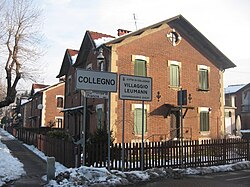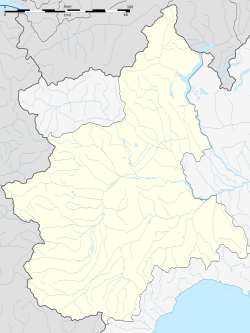Collegno
Collegno
Colegn (Piedmontese) | |
|---|---|
| Comune di Collegno | |
 The Leumann Village in Collegno. | |
| Coordinates: 45°5′N 7°35′E / 45.083°N 7.583°E | |
| Country | Italy |
| Region | Piedmont |
| Metropolitan city | Turin (TO) |
| Frazioni | Borgata Paradiso Di Collegno, Leumann, Regina Margherita, Savonera, Baricalla, Basse Dora, Bergera, Campo Sportivo, Gay, Provvidenza, Ricovero Provinciale[1] |
| Government | |
| • Mayor | Francesco Casciano |
| Area | |
| • Total | 18.10 km2 (6.99 sq mi) |
| Elevation | 302 m (991 ft) |
| Population (31 January 2022)[3] | |
| • Total | 48,491 |
| • Density | 2,700/km2 (6,900/sq mi) |
| Demonym | Collegnese(i) |
| Time zone | UTC+1 (CET) |
| • Summer (DST) | UTC+2 (CEST) |
| Postal code | 10093 |
| Dialing code | 011 |
| Patron saint | Saint Lawrence |
| Saint day | 10 August |
| Website | Official website[permanent dead link] |
Collegno (Italian pronunciation: [kolˈleɲɲo]; Piedmontese: Colegn [kʊˈlɛɲ] ) is a comune (municipality) in the Metropolitan City of Turin in the Italian region Piedmont, located about 9 kilometres (6 miles) west of Turin.
It occupies an alluvial plain at the end of the Val di Susa, between Rivoli and Turin, at the foot of Monte Musinè. The terminal course of the Dora Riparia flows in its territory.
History
[edit]Collegno originated as a Roman mansio 8 kilometres (5 mi) from Turin, known as Quintum Collegium (hence the modern name). Ancient findings from the area are now in the Museum of Antiquities in Turin.
From an ancient Roman villa, a richly decorated church was built at the beginning of the 5th century AD, dedicated to San Massimo, the first bishop of Turin.[4]
In 2002, during excavations for the construction of the terminal of line 1 of the Turin Metro, the remains of a Langobard settlement and necropolis came to light.[5] The site has been studied thoroughly until 2006, along with a nearby little gothic cabin's, previously settled.[6][7]
In 1641, Maria Cristina of France, regent of Savoy Dukedom, ordered the edification of a "Charterhouse" to host a monastery; the large building was designed by M. Valperga, the First Ducal Architect and completed by Juvarra. In 1851 the Monastery was transformed in a hospital for mental ills, then closed in 70s of the past century.
Lajos Kossuth, the exiled leader of the Hungarian Revolution of 1848 lived in the Baraccone section of the village from 1874 until 1882. The former politician bought a villa with a large garden not far from the train station, and spent his days with gardening, botanical expeditions to the Alps, writing his memoirs and receiving Hungarian guests. He was forced to sell the villa due to financial difficulties. The house was demolished in the 1970s.
Curious Facts
[edit]From 3 to 8 July 2017, the sports hall PalaCollegno guested the troops of "Sport Crime", the first ever sport based international TV series, including main characters and sport personalities Daniela Scalia and Luca Tramontin, and other basketball celebrities, such as former Italian ace Alessandro Abbio.
International relations
[edit] Antony, France
Antony, France Sárospatak, Hungary
Sárospatak, Hungary Volzhsky, Russia
Volzhsky, Russia Neubrandenburg, Germany
Neubrandenburg, Germany Cerdanyola del Vallès, Spain
Cerdanyola del Vallès, Spain San Gregorio Magno, Italy
San Gregorio Magno, Italy Oueslatia, Tunisia
Oueslatia, Tunisia Sarajevo, Bosnia and Herzegovina
Sarajevo, Bosnia and Herzegovina Havířov, Czech Republic
Havířov, Czech Republic Rocchetta Sant'Antonio, Italy
Rocchetta Sant'Antonio, Italy
See also
[edit]References
[edit]- ^ "Collegno (TO) - Sindaco e Amministrazione Comunale".
- ^ "Superficie di Comuni Province e Regioni italiane al 9 ottobre 2011". Italian National Institute of Statistics. Retrieved 16 March 2019.
- ^ Population data from Istat
- ^ "Collegno (Torino), necropoli gota e longobarda e villaggio - MuseoTorino". www.museotorino.it (in Italian). Retrieved 2024-08-26.
- ^ "Presenze Longobarde". Booklet delivered to visitors of the namesake exhibition, Collegno, 2004.
- ^ Pejrani Baricco, Luisella, ed. (2004). "Presenze longobarde. Collegno nell'Alto Medioevo". Soprintendenza per I Beni Archeologici del Piemonte.
- ^ Yijie Tian; et al. (2024). "The role of emerging elites in the formation and development of communities after the fall of the Roman Empire". Proceedings of the National Academy of Sciences. 121 (36): e2317868121. doi:10.1073/pnas.2317868121. PMID 39159385.
- ^ "Città gemellate". comune.collegno.gov.it (in Italian). Collegno. Archived from the original on 2019-12-13. Retrieved 2019-12-13.
External links
[edit]![]() Media related to Collegno at Wikimedia Commons
Media related to Collegno at Wikimedia Commons




